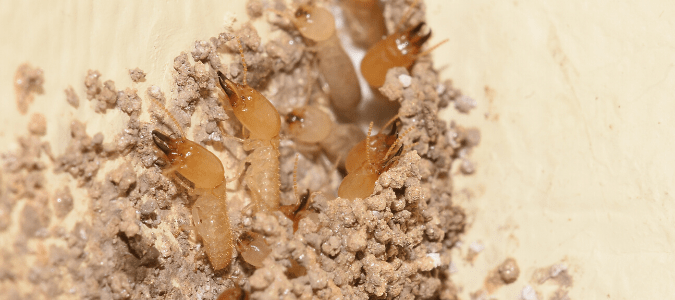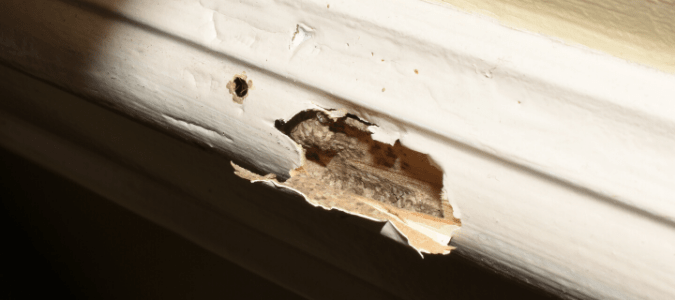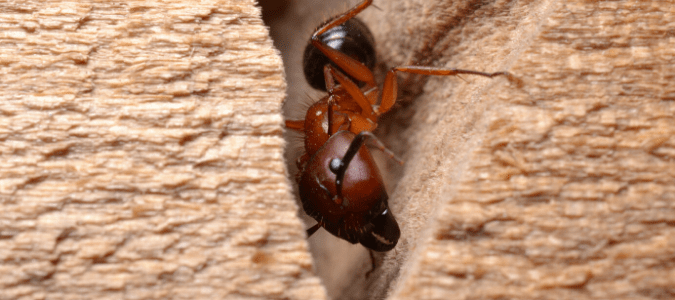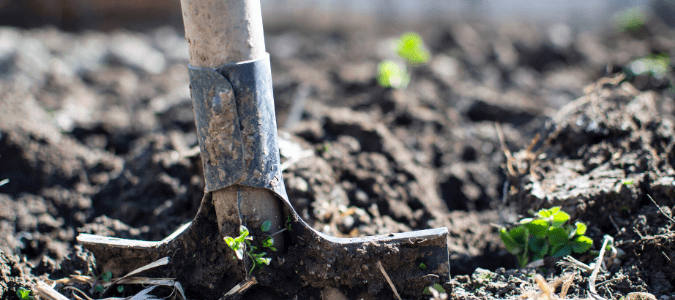
Yes, termites are harmful to humans, but perhaps not in the way you might immediately think. These creatures aren’t often responsible for serious physical harm, as they do not pose the same health risks as many other insect and animal pests that can bite or sting you or transmit disease. However, the destructive impact of termites on the structure of a home makes these pests extremely dangerous.
Only in rare cases have soldier termites bitten people while defending their colonies. While in the most severe infestation scenarios, occupants can experience contact dermatitis, asthma attacks and lung irritation, these instances of direct ill effects are relatively rare. However, left untreated, this insect can completely break down all the wooden structures in a wood-built house (including the furniture) within three years. Within five years, termites can render a home unfit for human habitation and cause it to be condemned. In short, termites are harmful to people because they can literally destroy your home.
Subterranean termites are the most common species of termite in North America, and they want to get to our homes for two main reasons: the cellulose in the wood that makes up our home is an ideal food source and the temperature inside allows them to be active all year round. They enter our homes either because there are home maintenance issues like slab leaks, there are termite-friendly materials leading up to the side of the house or both.
In order for a subterranean termite colony to flourish, a certain level of moisture must be maintained. Otherwise, the bugs simply can’t function. This is because, without a source of moisture, these soft-bodied creatures literally dry up and die.
Termites are also cold-blooded, meaning that weather greatly affects their activity. Studies show optimal soil temperatures for termite activity range from 75 to 95 degrees, while anything above 100 degrees or below 25 degrees may kill termites. Keep in mind, this is ideal soil temperature, so even if the temperature outside is not ideal weather for these destructive pests, termites can burrow as deep as 40 inches into the soil to reach their ideal temperature.
Unfortunately, many homeowners keep their homes at temperatures that are comfortable for termites. This, mixed with moisture around your home and the plentiful food source that is the foundation of your home, creates the ideal environment for a termite colony.
Once termites have found this perfect spot, they start congregating in one location and feeding in and around the wood surrounding a structure. The primary ways termites reach our homes are:
- Under the soil, in voids and through mud tunnels
- Through existing foundation cracks or other structural damage
- In mulch reaching your home’s siding
- Via humid crawl spaces with wood beams connected to the earth
- By way of soil-wood-home contact series—firewood or landscape timbers on the ground next to the house, for instance
Because of the innate need for connection to moisture, subterranean termites usually travel and infest largely unnoticed, as they mostly remain underground. Nevertheless, the sooner you can identify a potential infestation and address it, the better. In this post, we’ll address all of your questions about termite infestations, including how to identify termites, how to eliminate termite populations and how to make sure you never have to deal with these pests again. First, let’s talk about the common signs that you have subterranean termites on your property.

Subterranean Termite Evidence: Signs Of An Infestation
So how do you identify a pest issue before it even reaches the surface? Homeowners typically discover termite infestations either during swarm season or during home renovation or repair when inaccessible areas of the home are opened up. Otherwise, it can be difficult to detect subterranean termite activity. That said, there are a number of indicators of potential termite problems:
- Termite droppings called frass, that look like sawdust or wood shavings, found on window sills, carpet, flooring and beds
- Mud shelter tubes made of dirt and frass on wood structures
- Dips or holes in hardwood floors
- Mud spots, bubbles or peeling paint on your walls
- Moisture levels inside walls above 10 percent
- Seeing live termites probing
The other tricky thing about identifying termites is that there are three primary castes in subterranean termite colonies: worker, soldier and reproductive termites, and they all look slightly different.
Worker termites are about an eighth of an inch long, creamy-white with a soft body and no eyes. These termites have bead-like antennae and are the most numerous of the three. Workers typically remain inside the colony tunnels, working to feed and groom other castes and maintain and repair colony wood tunnels and mud tubes.
Slightly larger than workers, soldier termites are most easily identifiable by their large ant-like head capsules and over-developed mandibles, or jaws. Other than their size and mandibles, solider termites look very similar to their worker termite counterparts. Their only job is to protect the colony from predators and defend the physical nest.
In a termite colony, there are primary reproductive termites who will produce all of the eggs for the colony. You will be able to identify them because they are bigger than the other termites and they are also dark-colored with functioning eyes. One other differentiator is that reproductive termites have wings. You may hear these creatures called “swarming” termites. This caste of subterranean termites are often mistaken for carpenter ants.
If you believe you have spotted a termite on your property, try to confirm that what you are seeing is, in fact, a termite and not a carpenter ant. Treating for termites is very different than treating for carpenter ants, which is why it is vital to confirm which pest you are dealing with.

Do I Have Subterranean Termites Or Carpenter Ants? How To Tell
There are three ways to determine whether the flying insect you’re looking at is a termite or an ant: body structure, wing shape and antennae shape. Also, while termites typically don’t bite, you’re likely to receive a carpenter ant bite if they see you as a threat. Unfortunately, the first time people typically notice termites is during the swarming season, which is March through May, when the reproductive castes of both species are out and flying around. And, since swarming carpenter ants are about the same size and shape as swarming termites, the two are easy to confuse.
That said, here are a few ways to tell these pests apart:
- Body structure and size: A carpenter ant has three distinct body parts: head, abdomen and thorax. If you look at a swarming termite, on the other hand, you’ll only notice two: head and body. While a termite does have all three body parts, the head and the thorax are about the same size and tend to blend together. As far as size goes, termites are much smaller than carpenter ants. Termites measuring in at about an eighth to a quarter of an inch in length and carpenter ants are usually about a quarter to half an inch in length.
- Antennae shape: Ants have “elbowed” or bent antennae, while flying termites’ antennae are perfectly straight. According to research, ants’ feelers facilitate complex two-way communication, instead of just serving as receptors.
- Differences in wings: Both types of insects have four wings. Swarming ants have wings that are different lengths and that may appear a little yellow in coloration. All four wings on a flying termite are of equal length, are clear and are quite a bit longer than the length of their body.
Unfortunately, if you have either carpenter ant swarmers or termite swarmers on your property, this means these creatures are looking for a new place to nest and grow the colony further. At this point, you need to get serious about eliminating these pests on your property.

The Best Way To Kill Termites
Handling an infestation is an incredibly difficult thing to do on your own, as these colonies grow quickly. Even worse, these destructive pests will eat away at the cellulose in the wood that makes up your home all day, every day. Often, the quickest and easiest way to eliminate the colony is to contact a pest control professional to implement a treatment plan using targeted and scientifically-proven solutions. Since many homeowners are not familiar with termite activity and behavior, there are many questions that only an experienced technician can answer. Ridding your home and surrounding areas completely once a termite colony is on your property takes a multi-faceted approach.
Simply spot treating or killing surface swarmers will take care of what you can see, but what about the termites you don’t? Homeowners who want to attempt DIY control should know that the typical steps for eliminating a termite infestation include:
- Extensive inspection of a property to identify all colony locations in and around the home.
- Purchase of all needed personal protective equipment, including cartridge-type air filtering respirators, as well as protective gloves and clothing.
- Research into the most effective treatment solutions, which may not achieve the same results as the products available to professionals.
- Digging og trenches that are four to six inches wide and six inches deep into the soil along the foundation or on all sides of any existing piers—or both.
- Apply treatment products to the soil in your trenches.
- Secure access to all voids in your foundation walls and around your piers underneath the home, along with any other areas adjacent to your infestation, so that you can apply treatment products in these areas. This step often includes drilling into walls and being cognizant of electrical wiring and plumbing to avoid home damage and personal injury.
Skipping steps or making mistakes applying treatment products could leave your home vulnerable to future termite infestation. When this happens, you’ve wasted time and money, and still have to deal with the problem.
There are plenty of do-it-yourself termite control products available at local feed and hardware stores, and information on treating the issue yourself. But these methods are typically only effective on very small area applications and may not be effective in the long-term.
Really, the best way to handle a termite infestation is to put proper measures in place to make sure these destructive pests don’t find their way onto your property.

How To Prevent Termites In The First Place
Even if you determine that you don’t have a termite problem, you probably want to take preventative steps to protect your biggest investment. This means investing in routine maintenance, reducing moisture and keeping termite-friendly materials away from your home. Here are several specific ways you can help prevent future subterranean termite infestations.
- Reduce or eliminate excess moisture. You can do this by making necessary repairs to plumbing and structural damage that could allow moisture to accumulate. When your home is dry, it’s unattractive for subterranean termites and they may opt for another nesting spot.
- Install and maintain the proper rainwater diversion instruments. Make sure that your gutters, downspouts, splash blocks and landscaping drain systems are all directing water away from the perimeter of your home and that these are routinely checked so these are free of standing water (which will also prevent mosquitoes from laying eggs).
- Mind the gap. Maintain a minimum of 18 inches between your home and any natural materials such as soil, mulch and other landscaping matter. Store firewood at least 20 feet from your home.
- Sign up for ongoing monitoring. By incorporating routine inspections of your foundation and wood exteriors by experienced pest professionals, you can be notified of changes that indicate termite activity before a full-blown infestation takes place.
ABC Can Protect Your Property From Termite Damage
If you have noticed signs of termites or seen termites themselves, you’ll want to do everything you can to eliminate these pests as quickly as possible. Homeowners can rely on the experts at ABC Home & Commercial Services to pinpoint the source of your termite problem and implement a plan using scientifically proven treatment methods to make sure that you don’t have to worry about any more damage. Then, we can provide you with ongoing monitoring so you know that these pests won’t return.